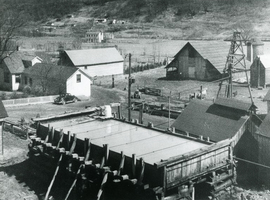 | Back to e-WV
| Back to e-WV
 The West Virginia Encyclopedia
The West Virginia Encyclopedia
 | Back to e-WV
| Back to e-WV
 The West Virginia Encyclopedia
The West Virginia Encyclopedia

Colonel John Dickinson, a veteran of the Battle of Point Pleasant and resident of Bath County, Virginia, had two tracts of land along the Kanawha River surveyed in November 1784. A tract of 502 acres at Campbells Creek included the famous salt spring; Joseph Ruffner purchased this property in 1796. A tract of 704 acres lay in the area of present Belle. In 1796, about three years before his death, Dickinson conveyed this tract to his sons-in-laws, Samuel and John Shrewsbury. They settled there about 1798. The brothers began to acquire additional land, establish farms, and operate a salt business. They encouraged brother Joel Shrewsbury and his business partner and brother-in-law, William Dickinson Sr., to come from Bedford County, Virginia.
Joel Shrewsbury and William Dickinson Sr. purchased property, rented a salt furnace, and moved their business to the Kanawha Salines (now Malden) in 1814. Dickinson and Shrewsbury along with John Dickinson Lewis and Lewis Ruffner were dubbed the ‘‘Salt Kings of Kanawha.’’ Lewis was a grandson of Col. John Dickinson. He first married Sallie, a daughter of Joel Shrewsbury. His second wife, Anne, was the daughter of the other partner, William Dickinson Sr. Two of Lewis’s daughters married the two sons of William Dickinson Jr.
The firm of Dickinson and Shrewsbury was consistently the largest user of slave labor in the county, employing the slaves at their salt works and at the mines that supplied fuel for saltmaking. The John Q. Dickinson salt furnace at Malden, established by Dickinson and Shrewsbury in 1832, was operated for more than 100 years by the Dickinson family. It was for many years the area’s last remaining salt operation.
William Dickinson Jr. (1798–1881) was born and reared in Bedford County, where he practiced law. He came to Kanawha in 1861 to handle the legal matters in the dissolution of the Dickinson-Shrewsbury partnership, which the courts finalized in 1866, after both partners had died. With his share of his father’s estate, in 1867 William Jr. largely founded the Kanawha Valley Bank, later One Valley Bank and BB&T, and now part of Truist Bank. Son John Q. was president from 1882 until 1925 and grandson John L. from 1925 until 1949. Henry Clay Dickinson, another son of William Dickinson Jr., was the mayor of Charleston when he died in 1871. Dickinson family descendants have figured prominently in the affairs of the bank and the community down to the present.
Written by Gerald S. Ratliff
Drennen, Bill. One Kanawha Valley Bank: A History. Charleston: 2001.
Miller, Thomas Condit, and Hu Maxwell. West Virginia and Its People vol. 2. New York: Lewis Historical Publishing, 1913.
Gallaher, DeWitt C. Genealogical Notes of the Miller- Quarrier-Shrewsbury-Dickinson Families. Charleston: Tribune Printing Co., 1917.